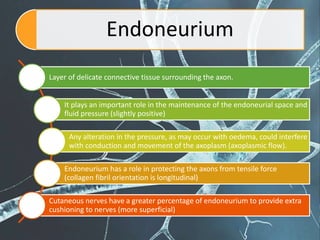NeuroD.pptx
- 1. (Khaled Hussein, MSc.PT ) Admin, Founder at Physio ( Facebook PT Education Group) Founder at AL Safwa PT Clinic Assistant Lecturer of Neurology, Cairo University Certified Clinical Nutritionist Neurodynamics in Practice
- 3. Endoneurium Layer of delicate connective tissue surrounding the axon. It plays an important role in the maintenance of the endoneurial space and fluid pressure (slightly positive) Any alteration in the pressure, as may occur with oedema, could interfere with conduction and movement of the axoplasm (axoplasmic flow). Endoneurium has a role in protecting the axons from tensile force (collagen fibril orientation is longitudinal) Cutaneous nerves have a greater percentage of endoneurium to provide extra cushioning to nerves (more superficial)
- 4. Perineurium Connective tissue wrapping surrounding a nerve fascicle. Perineurium Protect the contents of the endoneurial tubes,acting as a mechanical barrier to external forces. the last connective tissue sheath to rupture in tensile testing. collagen fibers run parallel, circular and oblique to nerve fibers “protect the nerve from kinking when it has to go around an acute angle (ulnar nerve at the elbow)”
- 5. Epineurium Whole nerve is surrounded by tough fibrous sheath. Maintains the course of peripheral nerve among different structures Acts as a shield against mechanical forces
- 7. spiral bands of Fontana’ With stretch, the lamellae of the myelin sheath slide on each other and the Schmidt Lantermann Clefts (SLC) open up , this allow considerable elongation of the axon Fascicles run in a wavy course throughout the nerve trunk This provides protection from compression and tensile forces, more so than if the fascicles ran in a straight line. Greater number of fascicles provides more protection for nerve from compressive forces
- 9. Blood Nerve barrier Mechanism A slightly positive pressure exists in the intrafascicular environment. This tissue pressure is referred to as the endoneurial fluid pressure (EFP) and is probably maintained by the elasticity of the perineurium. As well as protection from the exterior, this mechanism means that if the intrafascicular pressure increases, such as from an oedematous reaction), the barrier may close. A good example of the protective function of the diffusion barrier is where peripheral nerves travel through infected areas without nerve conduction being altered .The perineurial barrier is also resistant to trauma.
- 10. Nervi Nervorum Free nerve endings have been observed in the perineurium, epineurium and endoneurium pain from local pressure on a nerve to be due to the nervi Nervorum, it seems very likely that it plays a part in adverse tension syndromes it’s regarded as a protective mechanism for the nervous system, symptom production being a warning that the impulse conducting mechanisms may be in danger from mechanical or chemical compromise The nervi nervorum must be Considered a source of symptoms in diabetic neuropathy and in inflammatory polyneuropathics.
- 11. Nerve roots Although nerve roots are usually described as part of PNS, they are considered to be more a part of the central because: They lack Schwann cells They receive at least half of their nutrition from the cerebrospinal fluid. They involve the meninges
- 12. (Safety mechanisms) The dural sleeve forms a plugging mechanism which stops the nerve roots being pulled out of the intervertebral foramen and also a convenient force distributor.
- 13. Nerve roots inbuilt safety They lie in undulations and are able to unfold. Cerebrospinal fluid (CSF) supplies approximately half of the nerve root’s metabolic needs. CSF also cushions and protects the roots. Individual fascicles within the nerve root have the ability to slide on each other as they do in peripheral nerve.
- 14. Denticulate ligaments The Dural sleeves forms a plugging mechanism, stopping the nerve roots being pulled out of the intervertebral foramen. Traction is finally transmitted to the cord via the denticulate ligaments and this partially eased the tension on the nerve roots. Nerve roots also have their own inbuilt mechanisms (lie in undulations and are able to unfold) Nerve roots are surrounded by CSF which cushions and protects the roots
- 18. Consequences of nerve injury 0-impaired axoplasmic flow 0-hypersensitive Nervi Nervorum 1-Fibrosis 2-The double crush syndrome 3-Abnormal impulse generating mechanisms 4-Contracture of the nervous system
- 19. role of Sinuvertebral Nerves in chronic pain conditions Dura mater is innervated by segmental, bilateral, sinuvertebral nerves (Meningeal Branch Of Spinal Nerves ) The posterior longitudinal ligament, -Periosteum, -Blood vessels the annulus fibrosis, and Connective tissues of the anterior nerve roots. Root sleeves at cervical and lumbar levels have a richer nerve supply than the thoracic root sleeves Irritation of the sinuvertebral nerves is common with Dural dysfunctions, bony defects or osteoporosis of vertebral bones, spinal ligamentous injuries or hypertrophy , annular and discogenic conditions , leading to chronic pain and disability especially in cases of cervical and lumbar spondylosis
- 21. Explain management for these conditions Carpal tunnel syndrome Cervical disc pathology Lumbar canal stenosis Radial nerve injury Ulnar neuritis Sciatica Piriformis syndrome Pronator syndrome





















